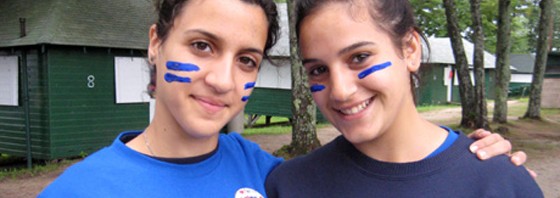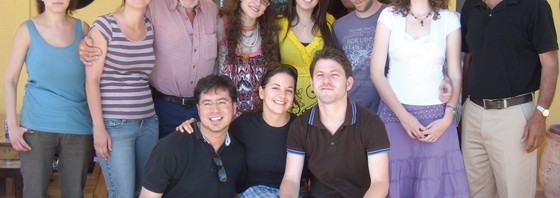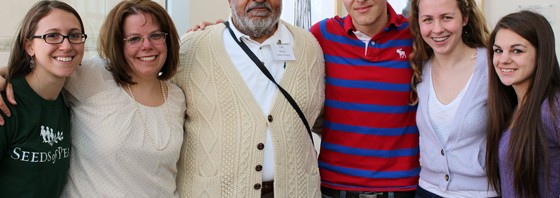If Middle East peace is to be attained, its groundwork must be put in place by young leadership. A summer camp in Maine brings teens together for this very reason.
BY JENNIFER FINER | At 15, Shouq Tarawneh, a Jordanian, began to feel that the facts and ideas she always accepted as truth needed clarification.
She saw Seeds of Peace, a program in the United States, as an opportunity to shed light on her feelings of darkness. It allowed her; if only temporarily, to live among Palestinians, Egyptians and Moroccans. Most important to Shouq, she would have her first face-to-face meeting with an Israeli.
Even after their countries agreed to live in peace, Shouq felt the images she had of her Israeli neighbors were nothing more than stereotypes. She wanted to clarify them. She had much hope for Seeds of Peace in Wayne, Maine.
“Before I came here, I felt like I was walking in a dark room,” Shouq said. “I had opinions without pictures. Seeds of Peace is like a door out of the dark.
“I’ve learned there are fences of superstition among all of us. We have old opinions of each other and … we’re here to destroy those fences.”
In mid-August, Shouq and her peers met in Boston for briefing sessions before spending two weeks at Camp Androscoggin, in central Maine.
The teens took buses to Washington for the final part of the program. They met with high-level government officials and toured the nation’s capital.
The third Seeds of Peace summer ended last week for 130 participants. They left Washington with a better understanding of each other. While the fences Shouq spoke of remain, many of the teens said they have a greater sensitivity toward how “the other side sees things” and now have a “face on the enemy.”
Seeds of Peace was founded in 1993 by John Wallach, a Jewish journalist who wrote several books on the Middle East, including a biography he co-authored with his wife Janet and PLO Chairman Yassir Arafat.
Mr. Wallach, who worked as a reporter and editor for Hearst Newspapers, planted the program’s initial seed shortly after the February 1993 bombing of the World Trade Center in New York.
“Something went off in the back of my head which said, ‘There has got to be a response to this type of terrorism,’” said Mr. Wallach, whose parents are Holocaust survivors.
“It occurred to me the only response was to get young people together who aren’t poisoned by the hostility of their region. With the peace process moving forward, this became possible like never before.”
Mr. Wallach chose to establish the camp in the United States because it would put campers on a neutral playing field. He also believed it made sense given America’s key role in mediating Middle East peace.
Before Mr. Wallach’s concept could become anything more than an idea, he needed to gain support. So he turned to Mr. Arafat, Israeli Prime Minister Yitzhak Rabin and other key Middle East leaders.
“I asked them to trust me with some of their teens,” Mr. Wallach said.
At first, the idea was difficult to sell, especially to Egyptian government leaders who, according to Mr. Wallach, were skeptical about sending their children to be with Israelis.
By the second summer, Morocco and Jordan began sending their teens. Although Lebanon and Syria were invited to participate, both declined.
Funding such an endeavor is challenging. All participants are heavily subsidized or completely funded. Parents are given the option to pay $500 of the $2,500 cost. Other funds come from American Jewish and Arab donors.
According to Mr. Wallach, private American donors, mostly Jews and some Arabs, contribute a majority of the budget. The rest comes from a number of foundations and individuals, including an anonymous Saudi Arabian, the American Chamber of Commerce in Egypt, the Blaustein Foundation, the Goldman Foundation of San Francisco, the Fox Family Foundation, the Streisand Foundation and Time Warner Inc.
Seeds of Peace isn’t exclusive to Middle East teens.
“We want to be responsive to areas of intense conflict,” Mr. Wallach said. To fulfill that goal, a handful of Bosnian and Serbian teens participated in this summer’s program.
“I can’t think of any other place in the world where Bosnians and Serbs are coexisting,” he said. “We don’t try to hide the difficult issues. Instead, we try to give them the skills they need to effectively debate their issues.”
When a bomb struck Sarajevo late last month, tensions at the camp escalated. The Bosnian reaction was, “We hate the Serbs.”
“We have to get them through these initial feelings and encourage them to sit down—with or without a facilitator—and talk,” Mr. Wallach said. “It took 24 hours of dialogue before the Bosnian and Serbian teens got back to their earlier level of friendship.”
While days are filled with swimming, canoeing and arts and crafts, evenings are spent in “coexistence groups.” Through theatrics, games and dialogue, the teens learn to solve conflict through open discussion.
“There is great difficulty involved in making real peace,” Mr. Wallach said. “The amount of hate and prejudice a 13-year-old brings with him shows us how hard we have to work to undo what’s been taught.”
Susan Siegel, a facilitator from New York, listened last month as a Palestinian girl told an Israeli girl, “I hate you,” and later apologized, saying, “I really don’t hate you, but that’s all I’ve ever learned.”
“Watching this process is draining and often frustrating,” said Ms. Siegel. “It’s an incredible challenge to work with kids who are so sophisticated and feel a strong sense of pride, passion and loyalty to their countries.”
During the coexistence groups, professional facilitators conduct workshops designed to extract open dialogue, allowing the teens to unleash their feelings.
Simultaneous evening sessions could be spent talking about gender differences, democracy and identity, while the next evening’s groups might deal with issues relating to values, prejudice, and negotiations and conflict resolution.
Every evening, facilitator Mitch Ross (son of former Michigan state Sen. Doug Ross), who is working toward a master’s in international conflict resolution, took different group members on a night hike where they experienced similar levels of fear and had to rely on each other for support.
Often the teens would sing because they had a need to hear each other’s voices and get through the hike together.
It was during these coexistence meetings that smiles often turned to tears, tempers flared, and differences came out.
On numerous occasions, talks focused on Jerusalem, an issue Israelis and Palestinians discussed passionately.
“We wanted to leave Jerusalem for the end because it’s hardest to talk about,” said Michael Hessel, 13, who grew up in Israel and recently moved with his family to Bethesda, Md.
“When we first discussed Jerusalem, I was hurt by a lot of what was said. Now I realize that’s what the Palestinians were taught.”
After a series of discussions with the Palestinian teens, Michael, who said he would rather die than lose Jerusalem, changed his thinking. He now says he might be more willing to recognize Jerusalem as the capital for Israel and the Palestinians. His friend, Daniel Shinar, an Israeli, doesn’t agree.
“Every time Israel makes peace, it has to give something away,” he said. “I have to a hard time understanding the Palestinian point of view. I try and put myself in their way of thinking and it’s somewhat easier to understand them. I can talk with the Palestinians and we can have fun together. But when trust is the issue, I don’t feel I can trust them 100 percent like I can the Jordanians and Egyptians. I still have the feeling with the Palestinian that he wants my land.”
Israelis found talks about the Holocaust equally disturbing. While some Arabs denied it ever happened, others maintained the number of Jewish deaths were exaggerated.
One morning, some of the Israeli teens returned to their Arab peers with facts on the Holocaust they obtained from the Internet.
For the most part, the deniers became less skeptical. Others asked, “How can we feel sorry for something that happened so many years ago when our relatives are being killed right now?”
A Palestinian teen named Abeer was disappointed the Israelis didn’t always accept her position. However, she thinks the camp has helped promote understanding.
Those who participated in the program were screened through a series of tests and interviews, and each wrote an essay on “Why I Want To Make Peace With the Enemy.”
Most of the participants were new to the program; others were returning peace makers. This summer was the first for Shouq of Jordan.
“I didn’t imagine myself talking to Israelis,” she said. “Here, they’re children before Israelis. Now I realize we are all children and, together, we act as the body of a child. If any part hurts us, it hurts all the kids in the world. If an Israeli and Palestinian has a problem, it’s my problem, too.
“Peace isn’t easy, but the bravery peace needs is not any less than the bravery war needs.”
Seeds of Peace participants arrive with the idea that making peace will be easy. Shortly into the program, they learn how difficult it is.
The camp director, Tim Wilson, a former professional football player and now a teacher in Pittsburgh, brought an added dimension. As an inner-city educator, Mr. Wilson deals with intercultural tensions daily.
“I believe in this program because it’s a place for kids to grow and share and hope,” he said. “A drip turns into a drop before it becomes a stream, then a river and then an ocean. I think we have future prime ministers and other leaders here who will be able to make a difference.”
Following the February 1994 Hebron massacre, when an Israeli shot 40 Palestinians in a mosque at the Cave of Machpelah, former Seeds of peace participants wrote a letter to their respective leaders, asking for Arab-Israeli peace talks to resume.
The teens wrote different drafts of their letter and through use of the fax machine a single letter was sent to both Prime Minister Yitzhak Rabin and PLO Chairman Yassir Arafat.
Mr. Wallach said encouraging the teens to work together, in ways similar to this peace letter, is difficult during the year.
To maintain dialogue, Seeds of Peace sends its participants a monthly newsletter containing articles written by the teens. Yearly reunions are held, and Mr. Wallach hopes to open regional centers in the Middle East so former participants can get together on a regular basis.
During camp, the teens, who had already found reason to use the Internet as a research tool, were exposed to the Internet so those who had never been on-line could learn and later use it for communication.
One evening after dinner, Michael Hessel, of Maryland, was “surfing the Net,” looking for information about the popular television show The Simpsons when a colorful display of Bart Simpson caught the eye of Tarek Shamma, a 13-year-old Egyptian. Tarek pulled a chair next to Michael and the two began discussing the show.
“When we first met, we were at the bottom of the pit,” Tarek explained. “Now, we are at the top of the mountain.”
Added Michael, “During a ‘coexistence’ at the beginning, I wasn’t very diplomatic with Tarek. After, I felt bad, and with the help of a third party we were able to reach an understanding.”
Tarek responded, “I wasn’t the type of person to say I hate Israelis. I’ve always had an open mind because my parents taught me never to be biased.”
When Tarek was chosen to be a part of the program, he said he considered it an honor, and his parents were pleased for the opportunity.
Many of the childrens’ parents, including Michael Hessel’s, encouraged their sons and daughters to participate. Michael’s grandparents, whom he describes as right-wing were not as encouraging.
“I started hating Arabs because of them,” Michael said.
Mr. Wallach calls the parents courageous for being willing to send their children to America to make peace with the enemy. He said it can be especially difficult for some because Arab terrorist groups target Arabs favoring armistice.
On Sept. 7, the Seeds of Peace teens ended their camp session. The last days were spent in Washington, where they met with U.S. Officials including Secretary of State Warren Christopher and Vice President Al Gore.
Mr. Gore stressed to the teens that the future is up to them. It’s not enough to sign papers, he said. Real peace is in your hands.





